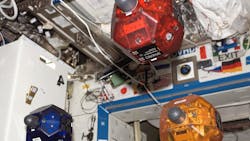Lockheed Martin and NASA Make Robots and Astronauts Working Together Possible
Lockheed Martin Advanced Technology Center (ATC) and NASA astronauts on the International Space Station are making it possible for robots and astronauts to work together in space. The team has organized control of the robots through astronauts in space and operators on Earth. This project is the first demonstration of collaborative tele-operations.
Developers astronaut Karen Nyberg and ATC engineer Humberto Ormeno used an ATC-developed, 3-D user interface to direct NASA’s Synchronized Position Hold, Engage, Re-orient, Experimental Satellites (SPHERES) robots on the space station. The robots (which are the size of a soccer ball) were commanded to perform exercises and different simulations of things they would be doing inside the space station. Some of these exercises included “follow-the-leader” and approach-and-docking maneuvers. The robots also exhibit flexibility. Automated control can be combined with manual control—they do not have to collectively be on the same setting.
Tele-operation—remotely controlling the robots in space—presents many obstacles. Commands and telemetry can have a time delay of one to three seconds when traveling between space and the ground via satellite relays. This problem forces operators to remotely predict the effects of their actions by referencing old data. Safe maneuvering is crucial, as delicate components created for weightlessness can be disrupted by accidental collisions or exhaust gases from other satellites.
Dr. Nelson Pedreiro reports that experiments are being done with SPHERES robots to confront the challenges. SPHERES allows ATC to work with astronauts who will run future missions. The facility at the space station was produced by MIT’s Space Systems Laboratory and provides an affordable way to test different hardware and software. SPHERES also provides a testing platform for the Defense Advanced Research Projects Agency and NASA. They test physical or mechanical properties of material in microgravity, as well as physical sciences investigations and free-flying spatial analyses. Along with its many significant uses, SPHERES provides the venue for the annual Zero Robotics student software programming competition. The facility is operated through NASA’s Ames Research Center in Moffett, Calif.
About the Author
Sarah Mangiola
Sarah Mangiola has written on many different topics within Penton's Design, Engineering, and Sourcing Group. Originally from California, she graduated from the University of California, Davis with a B.A. in political science.
